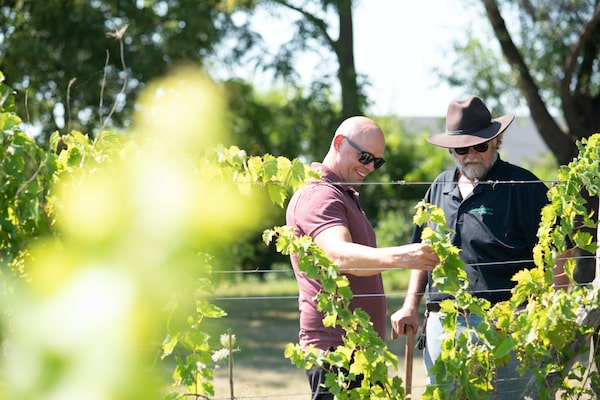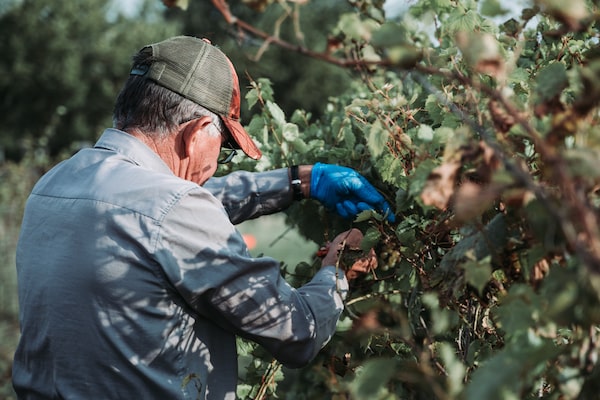
The Caldwell First Nations food adviser Bill Alexander, left, and wine adviser Dan Peltier inspect grapes during the September harvest.Kyra Cole/Handout
Sometimes the most inspired ideas are sparked by a chance discovery, which is exactly how Ontario’s Caldwell First Nation got into the wine-making business.
The Caldwells harvested their first batch of grapes in September and are on the road to opening Canada’s first Indigenous-operated winery east of British Columbia. The southwestern Ontario band decided to explore their prospects for wine-making after finding a hectare of grapes, including chardonnay and riesling varieties, on land they purchased earlier this year.
“We called in a wine expert, and he felt it was worth exploring,” says Kyra Cole, economic development officer for the band. That expert was Tom O’Brien, founder and co-owner of nearby Cooper’s Hawk Vineyards.
“It was a small vineyard, and the vines were in pretty rough shape,” O’Brien says. “But we pressed them, blended them with some of our grapes, and we made wine for them.” He says the result shows promise, and he’s looking forward to seeing how it turns out once it’s bottled.
With anticipation growing among band members and images of British Columbia’s Nk’Mip Cellars winery dancing in their heads, a feasibility study was undertaken. In November, the band council agreed to expand the vineyard and proceed with their own winery.
The first vintage will be bottled in the spring at Cooper’s Hawk under the Caldwell Three Fires label and sold to the public at the band’s new Three Fires restaurant when it opens in May in Leamington, south of Windsor. Those first wines will be barrel-fermented chardonnay, riesling and an amber or orange wine developed from a chardonnay musqué grape.
Once it’s operating, the Caldwells’ Three Fires winery will join the 15 other wineries of Essex County in the most southerly reaches of Ontario, which sit at the same latitude as the wineries of northern California and Tuscany.
The winery and restaurant are coming along just as the Caldwells establish their own reserve. Because they never signed the 1790 McKee Treaty, the Caldwell First Nation was the only band in southern Ontario without its own reserve land. In 2010, the Caldwells signed an agreement with the Canadian government and the search began for a suitable spot to establish themselves somewhere on their traditional Point Pelee lands.
Besides purchasing the vineyard and 80 hectares for a reserve, the Caldwells bought a nearby restaurant and marina just outside Point Pelee National Park near Leamington.

The first Caldwell grapes were harvested in September.Kyra Cole/Handout
Cole says the winery, restaurant and marina will form the nucleus of cultural development based on experiential tourism, which brings visitors into contact with places and the people who live there, to better understand the “essence” of those places. Since the number of participants is generally smaller for such hands-on experiences, it will be the perfect fit with a post-COVID world, she says.
“We’re going for sustainability. High-number activities are not sustainable tourism, in keeping people safe. Experiential tourism is small-scale yet profitable. We see people coming in their bubbles – colleagues, family units.”
Cole says people crave “a genuine cultural experience, and Indigenous communities want to tell their story.”
Calgary-based executive chef Bill Alexander was hired to establish the restaurant and blend his cuisine into that experience. Alexander, who grew up learning about Indigenous cuisine from his Ontario Mohawk mother, is also overseeing the restaurant’s makeover. Three Fires wines will be available for takeout as well as on-site consumption.
Alexander says statistics show one in three international travellers to Canada ask where they can find an authentic Indigenous cultural experience. He believes the Caldwell Nation can share their story, through their cuisine, with both non-Indigenous and Indigenous clients. “Food used to be something you ate on the way to where you were going. Now it is often an important part of the attraction itself,” he says.
Granted, wine is not a traditional part of the Indigenous story, Alexander says, but “we look at [wine] as part of our stewards-of-the-land philosophy. [We asked,] could we do wine differently, in a way that speaks to who we are as Indigenous people.” Once an expanded vineyard is established, he says, “we’re going organic.”
The wine will be paired with traditional Indigenous and locally sourced food – vegetables, venison and fish, for example – and flavoured with sage, sweetgrass, cedar, wild mint, horseradish, asparagus and berries.
Alexander points to the Wendake First Nation near Quebec City as one that developed a commercial enterprise – a hotel, restaurant and museum – while staying true to their Indigenous roots.
He is a passionate ambassador for Indigenous food and says he looks forward “to the day when Canadians can say, ‘I feel like having Indigenous [food] today,’ just as they would say ‘I’d like Greek or Italian.’ This is no fad food. The roots of Indigenous cuisine have been around for 14,000 years.”
Plan your weekend with our Good Taste newsletter, offering wine advice and reviews, recipes, restaurant news and more. Sign up today.